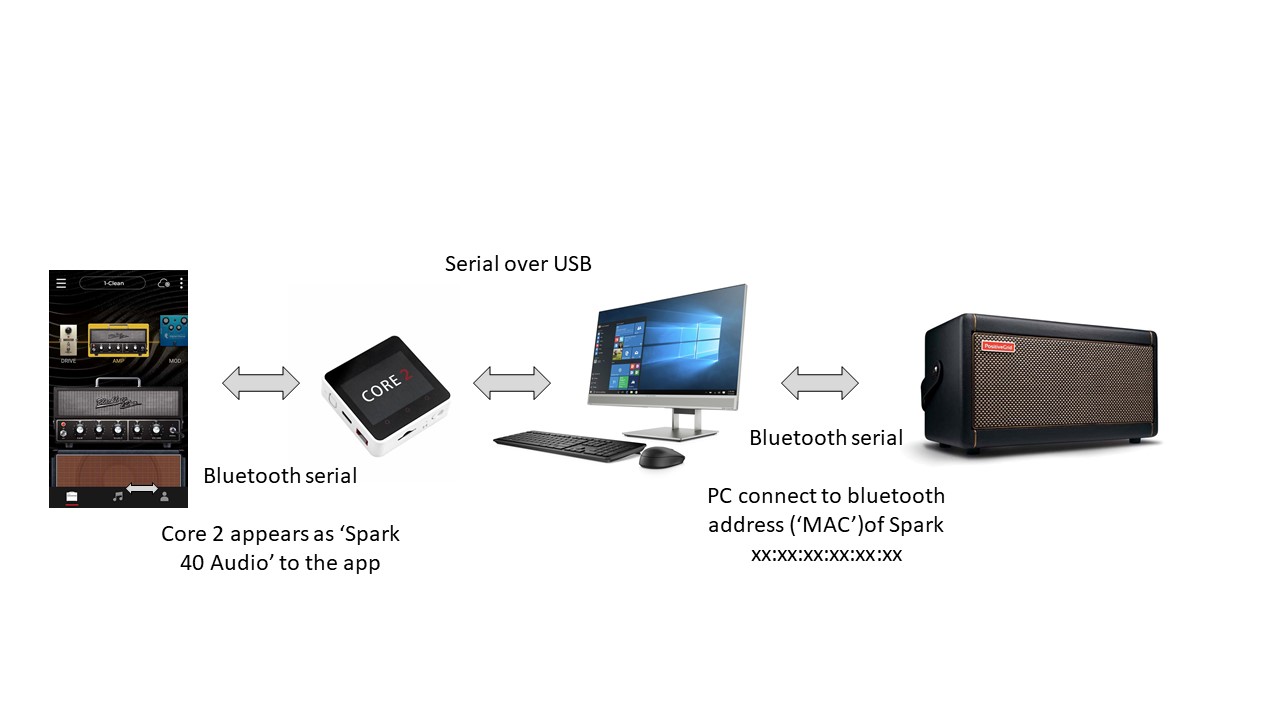
This is a suite of tools to analyse and mimic the bluetooth communication between the Spark app and the Spark amp.
My set-up is as below - the M5Stack Core 2 is an ESP32 board. This appears to the app as the Spark amp and sends the bluetooth traffic to the PC as serial over USB. The PC makes a connection to the bluetooth address of the Spark amp (to avoid connecting to the Core 2 again).
I can't get it to work with a single Core connected to amp and app.
This is a python class to create a preset in python 'bytes' format from an input like the one below.
It has been completely re-written now that the Spark messages are fully understood - hopefully it is a lot clearer and better structured to explain how to create a Spark bluetooth message from scratch.
It can also generate other messages to send to the spark, such as hardware preset change, effect on/off, change a parameter value (like gain), change an effect (eg swap one amp model for another).
It is the basis for Midi Contol (see next section)
preset = { "Preset Number": [0x00, 0x7f],
"UUID": "07079063-94A9-41B1-AB1D-02CBC5D00790",
"Name": "Silver Ship",
"Version": "0.7",
"Description": "1-Clean",
"Icon": "icon.png",
"BPM": 120.0,
"Pedals": [
{ "Name": "bias.noisegate",
"OnOff": "Off",
"Parameters": [0.138313, 0.224643, 0.000000] },
{ "Name": "LA2AComp",
"OnOff": "On",
"Parameters": [0.000000, 0.852394, 0.373072] },
{ "Name": "Booster",
"OnOff": "Off",
"Parameters": [0.722592] },
{ "Name": "RolandJC120",
"OnOff": "On",
"Parameters": [0.632231, 0.281820, 0.158359, 0.671320, 0.805785] },
{ "Name": "Cloner",
"OnOff": "On",
"Parameters": [0.199593, 0.000000] },
{ "Name": "VintageDelay",
"OnOff": "Off",
"Parameters": [0.378739, 0.425745, 0.419816, 1.000000] },
{ "Name": "bias.reverb",
"OnOff": "On",
"Parameters": [0.285714, 0.408354, 0.289489, 0.388317, 0.582143, 0.650000, 0.200000] }],
"End Filler": 0xb4}
msg = SparkMessage()
print("Preset ", preset["Name"])
b = msg.create_preset(preset_list[8])
send_preset(b)
print("Change to hardware preset 0")
b = msg.change_hardware_preset(0)
send_receive(b[0])
print ("Sweep up gain")
for v in range (0, 100):
val = v*0.01
b = msg.change_effect_parameter ("Twin", 0, val)
just_send(b[0])
print ("Change amp from Twin to SLO 100")
b = msg.change_effect ("Twin", "SLO100")
send_receive(b[0])
print ("Change amp from SLO 100 to Twin")
b = msg.change_effect ( "SLO100", "Twin")
send_receive(b[0])
print ("Turn on the Booster pedal")
b = msg.turn_effect_onoff ( "Booster", "On")
send_receive(b[0])
print ("Booster gain to 9")
b = msg.change_effect_parameter ("Booster", 0, 0.9)
just_send(b[0])
print ("Turn off Booster")
b = msg.turn_effect_onoff ( "Booster", "Off")
send_receive(b[0])
You can use the python routines below - as per the examples above.
change_effect_parameter (pedal, param, val)
change_effect (pedal1, pedal2)
change_hardware_preset (preset_num)
turn_effect_onoff (pedal, onoff)
create_preset (preset)
A python program for Windows or Raspberry Pi to interpret USB midi messages and send commands to the Spark - change hardware preset, send a complete preset, change effect, turn effect on / off and change a parameter for an effect (the parameter value is derived from a Midi CC message value in the range 0 to 127 and mapped to the 0.0 to 1.0 range. It is configurable with a table like below.
midi_map = {"NoteOn-40": ["HardwarePreset", 0],
"NoteOn-41": ["HardwarePreset", 1],
"NoteOn-42": ["HardwarePreset", 2],
"CC-21": ["ChangeParam", "Amp", 0],
"CC-22": ["ChangeParam", "Amp", 1],
"CC-23": ["ChangeParam", "Drive", 2],
"NoteOn-43": ["ChangeEffect", "Amp", "Twin"],
"NoteOn-36": ["EffectOnOff", "Drive", "On"],
"NoteOn-37": ["EffectOnOff", "Drive", "Off"]
}
Python functions to send commands to the Spark over bluetooth
Based on the outputs of the Spark Parser which analyses the data sent to the Spark
This works on a Windows 10 PC running Python 3.9 - using native sockets for bluetooth (which is only in Python 3.9)
Otherwise you need pip install pybluez and import bluetooth.
It also needs the bluetooth address of your Spark. BluettoothCL from NirSoft will find it (on Windows).
There is a version for the Raspberry Pi 400 which will also locate the Spark from its name rather than bluetooth address. This uses PyBluez which you need to pip install pybluez
Will take a preset in the format below and output the hex string and a python byte string.
preset = { "Preset Number": [0x00, 0x7f],
"UUID": "07079063-94A9-41B1-AB1D-02CBC5D00790",
"Name": "Silver Ship",
"Version": "0.7",
"Description": "1-Clean",
"Icon": "icon.png",
"BPM": 120.0,
"Pedals": [
{ "Name": "bias.noisegate",
"OnOff": "Off",
"Parameters": [0.138313, 0.224643, 0.000000] },
{ "Name": "LA2AComp",
"OnOff": "On",
"Parameters": [0.000000, 0.852394, 0.373072] },
{ "Name": "Booster",
"OnOff": "Off",
"Parameters": [0.722592] },
{ "Name": "RolandJC120",
"OnOff": "On",
"Parameters": [0.632231, 0.281820, 0.158359, 0.671320, 0.805785] },
{ "Name": "Cloner",
"OnOff": "On",
"Parameters": [0.199593, 0.000000] },
{ "Name": "VintageDelay",
"OnOff": "Off",
"Parameters": [0.378739, 0.425745, 0.419816, 1.000000] },
{ "Name": "bias.reverb",
"OnOff": "On",
"Parameters": [0.285714, 0.408354, 0.289489, 0.388317, 0.582143, 0.650000, 0.200000] }],
"End Filler": 0xb4}
preset_hex=[
"01fe000053fead000000000000000000f0013a15010124030000007f5924003037303739303600332d393441392d00343142312d41420031442d30324342004335443030373902302b53696c7665407220536869702308302e3727312d43106c65616e286963406f6e2e706e674a3242700000172e62006961732e6e6f6940736567617465424d1300114a3e0d210d6c01114a3e66080d5102114a0000000200284c41324143186f6d704313f7",
"01fe000053fead000000000000000000f0013a1501013403010000114a003000000001114a3f305a367e02114a3e093f034b27426f6f307374657242110073114a3f387b4a2b00526f6c616e644a304331323043150033114a3f215964012b114a3e104a360223114a3e22285d0333114a3f2b5b210463114a3f4e476d2640436c6f6e6572430d1200114a3e4c620c1b01114a00000002002c56696e746100676544656c61791b421400114af7",
"01fe000053fe81000000000000000000f0013a150101300302593e416a143601114a3e597b403602114a3e56721f1603114a3f000000012b626961732e7260657665726243171600114a3e12491b5601114a3e5113475602114a3e1437673603114a3e46517c0604114a3f1507530605114a3f2666666606114a3e4c4c4d0134f7",
]
Python code to parse the data packets sent and from a Spark Amp
This uses a M5Stack Core 2 ESP32 board connected to my PC via USB. The Core 2 appears as a Spark Amp to the Spark app on an Android tablet (over bluetooth serial) Does not work with iOS which I presume uses BLE.
All traffic to the 'amp' is captured and sent over USB as a serial stream.
The python program reads the serial input and parses it
This connects to the Spark Amp over bluetooth and receives and parsers messages from the Amp.
These are: change amp model, change effect parameter, change to another hardware preset, touch tap tempo and store to a hardware preset.
It can also interpret a preset sent to the 'app' in response to a preset information request.
Based on the work of Justin Nelson https://github.com/jrnelson90/tinderboxpedal and Yuriy Tsibizov https://github.com/ytsibizov/midibox
More information on https://github.com/paulhamsh/Spark-Parser


Leave A Comment?